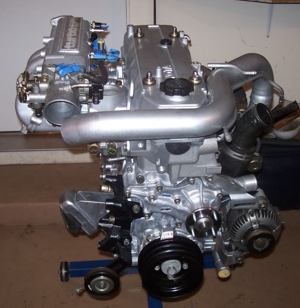Toyota 22R and 22R-E engine factory workshop and repair manual
 |
Toyota 22R and 22R-E engine factory workshop and repair manualon PDF can be viewed using PDF reader like adobe , or foxit or nitro . File size 18 Mb Searchable PDF document with bookmarks. Covers Maintenance Toyota 22R and 22R-E engine factory workshop and repair manual |
About the 22R engine
The Toyota R family was a variety of straight-4 gasoline engines. Created for longitudinal use in such cars as the Celica and Hilux and in manufacturing from 1953 through 1995, use faded out as numerous of Toyota's mainstream models relocated to front-wheel drive. OHC versions featured a chain-driven camshaft, mitigating the danger of internal damage from interference as in belt-driven engines.
The 2-valve SOHC 2.4 L (2,366 cc) 22R was produced from 1981 through 1995.Cylinder bore was 91.9 mm (3.62 in) and stroke was 88.9 mm (3.5 in).Initial output was 97 hp (72 kW) at 4,800 rpm and 129 lb at 3,400 rpm.
The first fuel injected 22R-E engines appeared in August 1982.Output of these engines is commonly rated at 105 hp (78 kW) at 4,800 rpm and 137 lb at 2,800 rpm.
In 1985, the engine was greatly reworked, output was up to 112 horsepower (84 kW) at 4,600 rpm and 142 lb at 3,400 rpm. Many parts from the newer 22R-E are not compatible with those from the older pre-1985 engine. Non-compatible areas include the cylinder head, block, pistons and numerous of the connected parts such once the timing chain and cover, and water and oil pumps (although the oil pump internals are the same). These changean in addition affected the 22R, therefore one can give consideration to the 85-95 22R-E as a fuel injected version of the 85-90 22R with only small differences, if any.
Toyota swapped the dual row timing chain found in old engines for a unmarried row company with plastic guides in 1983. This program decreased pull on the system, but was occasionally problematic. Every 80,000 to 140,000 kilometers the chain would occasionally stretch to the point that the hydraulic-operated chain tensioner can not take up any more slack. Whenever this happens, the moment chain impacts the driver's side chain guide, breaking the plastic within a few hundred miles of driving and adding a noticeable chattering sound within the front of the engine, especially when cold. If the engine continues to become operated after the guide breaks the chain will stretch fast (an unfortunate characteristic of single row chains). The relaxed chain causes inaccurate ignition moment which usually results in noticeable rough running. In continued operation, the chain can jump a tooth on the drive sprocket or break completely, with either case resulting in engine damage from valve-piston collisions. Also, the stretched company will slap against the part of the timing cover due to the broken manual, and can wear through the cover and into the coolant passage behind the water pump. This will cause coolant to drain in to the crankcase / oil pan, perhaps causing damage to inside engine components such as the bearings, crankshaft, camshaft along with damage caused by overheating due to the absence of coolant (since it has exhausted into the engine oil).A popular modification to the 22R is to use a 20R mind. This mind has smaller combustion chambers, giving a higher compression ratio, which then allows more power to be developed. The 20R head also flows better than the 22R mind, which improves high RPM power. The 20R head is a simple bolt-on modification for the early, pre 1985, block, but also requires the utilization of the 20R consumption manifold, generating it impossible to use with the 22RE EFI system. For the later, 1985 onwards, 22R block, further modifications are required.
22R
1981 Toyota Corona
1981-1988 Toyota Hilux
1981-1984 Toyota Celica
1981-1995 Toyota Pickup
1984 Toyota 4Runner
22R-E
1985-1995 Toyota Hilux
1983-1985 Toyota Celica
1985-1995 Toyota Pickup
1985-1995 Toyota 4Runner

 0 Items (Empty)
0 Items (Empty)